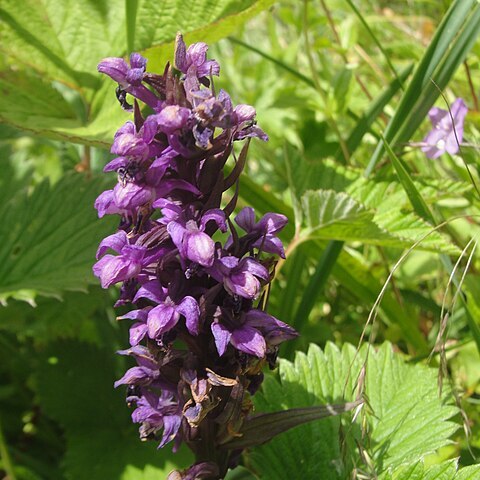Plants slender to robust, 10-40 cm tall. Tubers palmately 3-5-lobed. Stem erect, stout, hollow in robust plants, with 2 or 3 tubular sheaths at base, 3-6-leaved. Leaves erect or spreading, clustered and subopposite near base of stem, widely spaced and alternate above, green, not spotted, oblong to linear-lanceolate, (5-)8-15 × 0.8-3 cm, apex obtuse or acuminate. Rachis 2-15 cm, subdensely several to densely many flowered; floral bracts lanceolate, basal ones to 4 cm, becoming smaller above, exceeding ovary, apex acuminate. Flowers not secund, lilac to purplish rose, medium-sized; ovary and pedicel 8-14 mm. Sepals and petals lilac or purplish rose; dorsal sepal erect, ovate-oblong, concave, 5.5-7(-9) × 3-4 mm, 3-veined, apex obtuse; lateral sepals ovate-lanceolate to ovate-oblong, oblique, 6-8(-9.5) × 4-5 mm, 3-5-veined, apex obtuse. Petals erect, forming a hood with dorsal sepal, ovate-lanceolate, slightly oblique, 5.5-7 × 3-5 mm, 2-or 3-veined, apex obtuse; lip ovate to suborbicular, 6-9 × 6-10 mm, usually slightly broader than long, base spurred, margin entire to shallowly 3-lobed toward apex, margin slightly crenulate, apex or mid-lobe obtuse, disk minutely papillose, purplish red to rose, sometimes whitish toward base with a spoon-shaped patch of dark purple spots or lines; spur pendulous, ± straight to slightly curved forward, cylindric to conic, to 12 mm, equaling to slightly shorter than ovary, apex obtuse. Fl. Jun-Aug. 2n = 40, 80.
More
An orchid. It grows to 45 cm high. The stem is stout and leafy. The roots are tuberous. They are slightly flattened and divided into 3-5 finger-like lobes. The leaves are 6-12 cm long by 2-4 cm wide. They are oblong and the base sheaths the stem. The flowers are purple. They are narrowly sword shaped.

